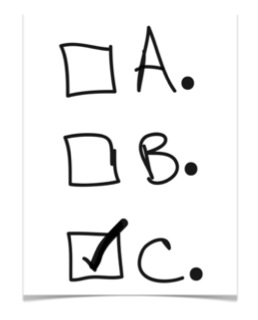The following article is an excerpt from my e-book SAT Grammar Crammer!
Pronoun Case: “Him don’t talk so good…”
Pronoun case error is the topic that covers the question:
“Is it Bradley and I or Bradley and me?”
Each of these options can be correct when used properly; you just need a way to know which of the two to use, every time.
OK – there are two ways to deal with this common error on the SAT writing section:
Method 1) Try each word by itself and trust your ear (perhaps about 75% effective for most students)
OR
Method 2) Think about it the “grammar teacher” way (harder to learn but more powerful – can achieve 100% effectiveness)

Get Exclusive SAT Prep Tips!
I want to send you more tips to help your SAT score, but I need your email address to stay in touch. Enter your email below so I can send you my reports on the SAT and other subscriber-only bonuses.
I’ll explain both ways, and you can pick the one you prefer.
I myself use a blend of both – I trust my ear 9 times out of ten, but when I’m uncertain, I take a “grammar teacher” approach.
Method 1: Try each word by itself and trust your ear. This style focuses on 4 steps:
Step A) Noticing the presence of pronouns in the sentence
Step B) Trimming the sentence down to its basics,
Step C) Occasionally rearranging word order without changing sentence meaning, and
Step D) Trusting your “inner ear” to determine the right pronoun to use (he/him? They/them? etc.)
We will practice each of the four steps when we look at the questions from the pretest, but for now let me lay them out for you:
Step A) You should always be looking for pronouns on the SAT! This step overlaps with at least two other important topics: Subject/Verb Agreement and Pronoun Number Agreement. No pronoun should go unexamined on the entire grammar test! Never break this rule!
Step B) Practice eliminating unnecessary detail. There is a special trick to this in pronoun case questions that you’ll soon see. Again, this step is an important strategy and tool you can use on every single SAT grammar question, so you should always eliminate details to some degree, even if you are “pretty sure” you know what the mistake is. You may be surprised once the details drop out.
Step C) When the SAT writers test this grammar topic, they frequently make matters appear more complicated than they really are, by choosing a word order that is uncommon or unnatural, at least compared to your typical everyday speech. In many cases, you can beat them at their own game by rearranging the order of the sentence into a more familiar-sounding style of speech.
Step D) “Trust your inner ear.” Try the pronoun both ways in the reduced, re-ordered sentence. Go with the one that sounds more familiar to you. You won’t get it right every single time, but you’ll certainly improve.
To get the complete text of this SAT Grammar lesson, along with over 14 other lessons, two diagnostic tests and two hundred SAT Writing practice questions written by a two-time perfect-scorer and pro SAT tutor, download your copy of The Top 12 SAT Writing Grammar Rules today!
Further Reading:
What exactly is on the SAT Writing section?
SAT Writing Strategy: Rearranging Word Order
SAT Writing Strategy: Eliminating Details
SAT Writing Rules: Subject-Verb Agreement
SAT Writing Rules: Pronoun Number Agreement
Additional Resources:
SAT Grammar Crammer: Top 12 Rules for the SAT Writing Test
Before you leave, be sure to join my SAT prep email list. I’ll send you subscriber-only content like my Urgent Report on SAT Reading and other bonuses to help your score!


















Find Me on Social Media